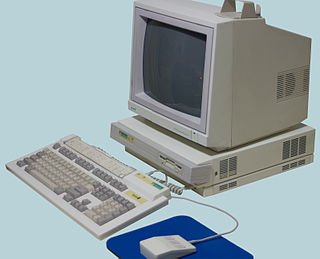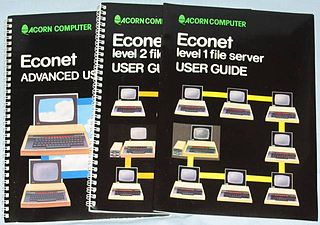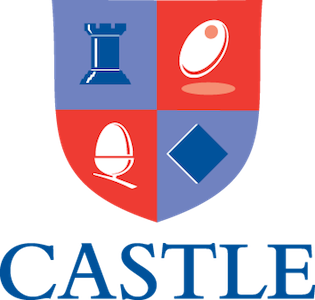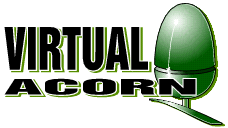Related Research Articles

Acorn Computers Ltd. was a British computer company established in Cambridge, England, in 1978. The company produced a number of computers which were especially popular in the UK, including the Acorn Electron and the Acorn Archimedes. Acorn's BBC Micro computer dominated the UK educational computer market during the 1980s.

Risc PC was a range of personal computers launched in 1994 by Acorn and replaced the preceding Archimedes series. The machines had a unique architecture unrelated to IBM PC clones and were notable for using the Acorn developed ARM CPU which is now widely used in mobile devices.

Acorn Archimedes is a family of personal computers designed by Acorn Computers of Cambridge, England. The systems are based on Acorn's own ARM architecture processors and the proprietary operating systems Arthur and RISC OS. The first models were introduced in 1987, and systems in the Archimedes family were sold until the mid-1990s.

RISC OS is a computer operating system originally designed by Acorn Computers Ltd in Cambridge, England. First released in 1987, it was designed to run on the ARM chipset, which Acorn had designed concurrently for use in its new line of Archimedes personal computers. RISC OS takes its name from the reduced instruction set computer (RISC) architecture it supports.

RISC iX is a discontinued Unix operating system designed to run on a series of workstations based on the Acorn Archimedes microcomputer. Heavily based on 4.3BSD, it was initially completed in 1988, a year after Arthur but before RISC OS. It was introduced in the ARM2-based R140 workstation in 1989, followed up by the ARM3-based R200-series workstations in 1990.
Mark Colton was a British racing driver and software author.

Econet was Acorn Computers's low-cost local area network system, intended for use by schools and small businesses. It was widely used in those areas, and was supported by a large number of different computer and server systems produced both by Acorn and by other companies.
Timeworks Publisher was a desktop publishing (DTP) program produced by GST Software in the United Kingdom.
Xara is an international software company founded in 1981, with an HQ in Berlin and development office in Hemel Hempstead, UK. It has developed software for a variety of computer platforms, in chronological order: the Acorn Atom, BBC Micro, Z88, Atari ST, Acorn Archimedes, Microsoft Windows, Linux, and more recently web browser-based services.
The Acorn Business Computer (ABC) was a series of microcomputers announced at the end of 1983 by the British company Acorn Computers. The series of eight computers was aimed at the business, research and further education markets. Demonstrated at the Personal Computer World Show in September 1984, having been under development for "about a year" and having been undergoing field trials from May 1984, the range "understandably attracted a great deal of attention" and was favourably received by some commentators. The official launch of the range was scheduled for January 1985.

Castle Technology Limited, named after Framlingham Castle, was a British computer company based in Cambridge, England. It began as a producer of ARM computers and manufactured the Acorn-branded range of desktop computers that run RISC OS.
The Fourth Dimension (4D) was a major video game publisher for the BBC Micro, Acorn Electron, Acorn Archimedes and RiscPC between 1989 and 1998. Previously, The Fourth Dimension had been known as Impact Software, which specialised mainly in BBC Micro games. Some of 4D's staff had worked for Superior Software. Notable release included Cyber Chess, Stunt Racer 2000, Galactic Dan and Chocks Away.
Designer Castles was a software title for the BBC Micro and later Acorn Archimedes range of computers.

The A7000 and A7000+ were Acorn Computers' entry level computers based somewhat on the Risc PC architecture.
Protext is a British word processing program, developed by Arnor Ltd, of Peterborough in the decade following 1985. Originally written for the Amstrad CPC 464, it was later sold for the Amstrad PCW series of word processors, for MS-DOS based PCs, the Atari ST, and the Commodore Amiga.

RISC OS Open Ltd. is a limited company engaged in computer software and IT consulting. It is managing the process of publishing the source code to RISC OS. Company founders include staff who formerly worked for Pace, the company which acquired RISC OS after Acorn's demise.
RISCOS Ltd. was a limited company engaged in computer software and IT consulting. It licensed the rights to continue the development of RISC OS 4 and to distribute it for desktop machines from Element 14 and subsequently Pace Micro Technology. Company founders include developers who formerly worked within Acorn's dealership network. It was established as a nonprofit company. On or before 4 March 2013 3QD Developments acquired RISCOS Ltd's flavour of RISC OS. RISCOS Ltd was dissolved on 14 May 2013.
RISC OS, the computer operating system developed by Acorn Computers for their ARM-based Acorn Archimedes range, was originally released in 1987 as Arthur 0.20, and soon followed by Arthur 0.30, and Arthur 1.20. The next version, Arthur 2, became RISC OS 2 and was completed and made available in April 1989. RISC OS 3 was released with the very earliest version of the A5000 in 1991 and contained a series of new features. By 1996 RISC OS had been shipped on over 500,000 systems.

VirtualAcorn is the brand name of several commercial emulators of Acorn Computers computer hardware platforms.

In computing, Aemulor is an emulator of the earlier 26-bit addressing-mode ARM microprocessors. It runs on ARM processors under 32-bit addressing-mode versions of RISC OS. It was written by Adrian Lees and released in 2003. An enhanced version is available under the name Aemulor Pro.
References
- ↑ "Impression 20 years ago". Risc World . 2009. Retrieved 27 October 2013.
- 1 2 "First Impressions". Acorn User. May 1989. p. 7. Retrieved 27 March 2021.
- ↑ Bell, Graham (May 1990). "Easy to Impress". Acorn User. pp. 113–115. Retrieved 23 December 2020.
- ↑ Archimedes Software Applications Catalogue (PDF). Acorn Computers Limited. January 1988. p. 15. Retrieved 25 April 2021.
- ↑ "Arthur at risk from Concepts' new OS". Acorn User. June 1988. p. 7. Retrieved 31 October 2020.
- ↑ "Arc DTP Update". Acorn User. August 1990. p. 9. Retrieved 6 May 2021.
- ↑ Lynch, Ian (March 1990). "DTP Column". Archive. pp. 36–37. Retrieved 16 April 2021.
- ↑ "Impression II". The Archimedean. Computer Concepts Limited. September 1990. pp. 4–5. Retrieved 8 April 2021.
- ↑ Acorn Publishing System Product Directory (PDF). Acorn Computers Limited. January 1992. Retrieved 13 February 2021.
- ↑ "The Acorn Publishing System". The Archimedean. No. 5. 1992. p. 6. Retrieved 13 February 2021.
- 1 2 "Impression Junior". The Archimedean. Computer Concepts Limited. September 1990. p. 5. Retrieved 8 April 2021.
- ↑ Bell, Graham (December 1990). "First Impressions". Acorn User. pp. 123, 125. Retrieved 8 April 2021.
- ↑ "Advance". The Archimedean. No. 7. 1993. p. 3. Retrieved 28 May 2021.
- ↑ "Just the Business". Acorn User. June 1991. p. 7. Retrieved 2 June 2021.
- ↑ Bell, Graham (April 2021). "Acorn Advance". Acorn User. p. 25. Retrieved 8 April 2021.
- ↑ "Junior goes free". Acorn User. September 1997. p. 6. Retrieved 25 October 2021.
- ↑ "CC Creates New Impressions". Acorn User. October 1993. p. 9. Retrieved 8 April 2021.
- ↑ "Impression changes". The Archimedean. No. 8. Computer Concepts Limited. 1993. p. 3.
- ↑ "Impression Publisher". The Archimedean. No. 9. Computer Concepts Limited. 1994. pp. 7–8.
- ↑ Hallas, Richard (January 1994). "Doing it in Style". Acorn User. pp. 77–78. Retrieved 3 July 2021.
- ↑ Hallas, Richard; Powell, Steve (June 1994). "The best impression". Acorn User. pp. 57–59. Retrieved 3 July 2021.
- ↑ "Three for one". The Archimedean. No. 10. Computer Concepts Limited. 1994. p. 3.
- ↑ "Spread the Word". Acorn User. September 1990. p. 7. Retrieved 16 April 2021.
- ↑ "Acorn Comes to Aid of Third Party". Acorn User. October 1990. p. 7. Retrieved 16 April 2021.
- ↑ "Publisher Plus". The Archimedean. No. 10. 1994. Retrieved 19 May 2021.
- ↑ Powell, Steve (December 1994). "Professional publishing". Acorn User. pp. 40–41. Retrieved 9 July 2021.
- ↑ "BAU Now Produced on Arc DTP". Acorn User. January 1991. p. 7. Retrieved 11 May 2021.
- ↑ Monk, Barry (August 1991). "From Scalpel to Screen". Acorn User. pp. 56–57, 59. Retrieved 4 June 2021.
- ↑ Moxon, Mark (May 1994). "Viewpoint". Acorn User. p. 45. Retrieved 24 July 2021.
- ↑ Moxon, Mark (February 1995). "Editor's letter". Acorn User. p. 4. Retrieved 24 July 2021.
- ↑ Moxon, Mark (February 1995). "Hot off the press". Acorn User. pp. 41–43. Retrieved 24 July 2021.
- ↑ Kreindler, Jack (October 1993). "Let's get physical". Acorn User. pp. 35–37. Retrieved 5 July 2021.
- ↑ Michael Lockwood (1996). Opportunities for English in the Primary School. Trentham Books. p. 124. ISBN 978-1-85856-046-5.
- ↑ Mellor, Phil (23 March 2007). "An arbitrary number of possibly influential RISC OS things". The Icon Bar . Retrieved 27 October 2013.
- ↑ Matthewman, David (October 1994). "I wrote that..." Acorn User. pp. 71–72. Retrieved 5 July 2021.
- 1 2 Williams. Chris (4 Oct 2003). "X-Ample touts 32bit Impression". Drobe . Retrieved 27 October 2013.
- ↑ Goodwin, Richard (4 October 2003). "Impression DTP - the return". The Icon Bar . Retrieved 27 October 2013.
- ↑ Williams. Chris (30 Oct 2004). "Dude, where's my Impression-X?". Drobe . Retrieved 27 October 2013.
- ↑ Williams. Chris (15 March 2005). "Light at end of Impression-X tunnel". Drobe . Retrieved 27 October 2013.
- ↑ Hudd, Vince M (5 May 2015). "Impression-X on !Store and in Holland". RISCOSitory . Retrieved 8 May 2015.
- ↑ Williams. Chris (24 November 2000). "OvationPro Publisher Pack: Drobe looks at the new features of the DTP". Drobe . Retrieved 30 April 2016.
- ↑ Previous Drobe article published 24 November 2000
- ↑ Tomkinson, Mike (November 1997). "Hardware on the move". Acorn User . Retrieved 27 October 2013.
- ↑ "No dongles". The Archimedean. No. 6. Computer Concepts Limited. 1992. p. 5.